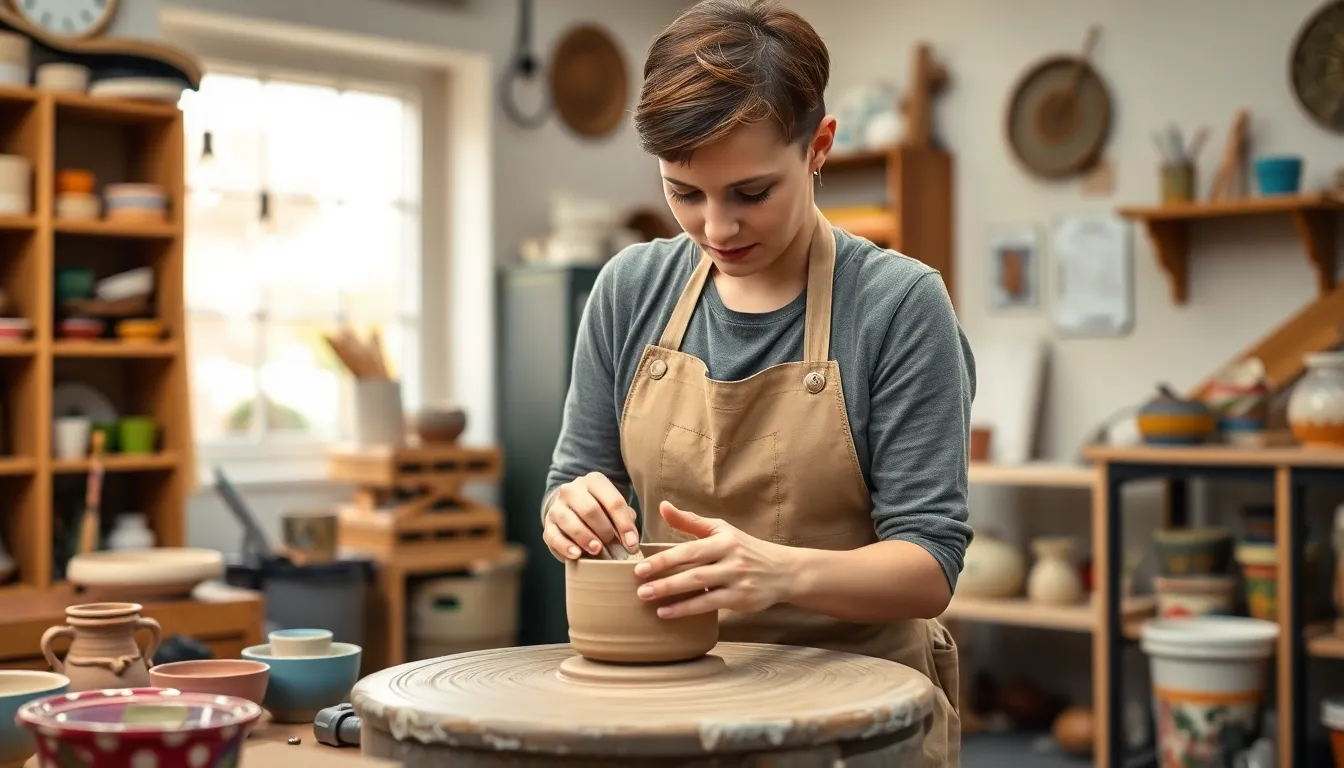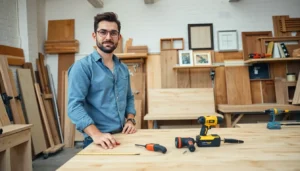Unleash your inner artist and dive into the world of ceramic DIY projects! Whether you’re a seasoned pro or a complete newbie, working with clay can be a delightful way to express creativity while adding a personal touch to your home. Imagine transforming a lump of clay into a stunning vase or a quirky mug that sparks joy every time you sip your morning coffee.
Table of Contents
ToggleOverview of Ceramic DIY Projects
Ceramic DIY projects offer diverse opportunities for creativity and self-expression. Novice crafters find enjoyment in simple tasks, while experienced artisans tackle more complex designs. Transforming raw clay into functional or decorative items enriches the crafting experience.
Pottery involves various techniques such as hand-building, wheel throwing, and glazing. Each method allows for unique creations. Hand-building suits beginners due to its straightforward approach, allowing for personal touches. Wheel throwing, though requiring practice, produces professional-looking results.
Glazing adds character and protection to ceramic pieces. Various glaze types create diverse finishes, ranging from glossy to matte. Experimenting with colors and patterns leads to striking results, heightening the overall appeal of the projects.
Common projects include planters, tableware, and decorative sculptures. Planters make excellent functional additions to homes, while tableware enhances dining experiences. Decorative sculptures serve as conversation starters and unique art displays.
Home décor benefits from personalized ceramic items. Vases and bowls capture individual style and creativity. Custom pieces often become cherished gifts, celebrating special occasions or milestones.
Community workshops and online tutorials provide valuable resources for beginners and experts alike. Local studios often host classes, promoting collaboration and sharing of techniques. Online platforms offer endless inspiration, ranging from beginner how-tos to advanced techniques.
Participating in ceramic DIY projects fosters a sense of accomplishment. Creating unique items brings joy and satisfaction, making every finished piece a testament to creativity and effort. Embracing ceramics opens up a world of artistic possibilities.
Popular Ceramic DIY Techniques

Ceramic DIY projects incorporate various techniques, allowing creators to express their unique styles. Two prominent methods, hand-building and wheel throwing, cater to different skill levels and artistic preferences.
Hand Building
Hand-building offers a user-friendly approach, making it ideal for beginners. Creating shapes with just one’s hands and basic tools fosters creativity and inventiveness. Techniques like pinch pots, coil building, and slab construction emphasize personal expression. Pinch pots allow crafters to shape bowls or vases easily, while coil building helps construct larger, more complex structures. Slab construction provides flexibility for making tiles or intricate sculptures. These methods encourage experimentation, leading to truly distinctive pieces.
Wheel Throwing
Wheel throwing presents an exciting challenge for those seeking refined craftsmanship. This technique involves using a pottery wheel to shape clay into symmetrical forms. Crafting bowls and mugs becomes an enjoyable process when mastering this skill. The wheel’s spinning motion aids in achieving even thickness throughout the piece, resulting in professional-looking products. Beginners may need practice to gain proficiency, but the satisfaction of creating beautiful items makes it worthwhile. Combining wheel throwing with glazing enhances the final result, adding vibrancy and texture to each piece.
Essential Tools and Materials
Ceramic DIY projects require specific tools and materials to achieve successful outcomes. Both beginners and experienced crafters can benefit from having the right items at hand.
Tools for Beginners
Beginners should prioritize essential tools when starting their ceramic journey. A basic set of tools includes a rolling pin, useful for flattening clay, and a cutting wire, perfect for slicing through blocks of clay. A sponge aids in smoothening surfaces and adding moisture, while a needle tool helps in detailed work like trimming or scoring. Additionally, a set of pottery ribs provides versatility for shaping and finishing pieces. Safety equipment like a dust mask protects against inhaling clay dust. Investing in these fundamental tools supports a smoother crafting process.
Recommended Clay Types
Selecting the right clay type significantly impacts project success. Earthenware is great for beginners, featuring a low firing temperature and easily manageable texture. Stoneware provides durability and versatility, suitable for both hand-building and wheel throwing. Porcelain offers a refined, translucent quality, but it requires more skill due to its challenging nature. Air-dry clay presents a user-friendly option that doesn’t require a kiln, making it ideal for casual projects. Each clay type opens different possibilities, allowing crafters to choose based on their comfort level and desired outcome.
Step-by-Step Project Ideas
Ceramic DIY projects allow crafters to explore creativity through hands-on activities. Various options cater to different skill levels, ensuring enjoyment for everyone.
Ceramic Pots and Planters
Creating ceramic pots and planters offers an opportunity for personal expression. Start with hand-building techniques like pinch pots or coil building. Shaping the clay into unique designs adds character. Incorporate drainage holes for plant health. Once shaped, apply a glaze that complements the décor. Allow the piece to dry and fire it in a kiln or use air-dry clay for simplicity. These custom planters enhance indoor or outdoor spaces.
Decorative Tiles
Crafting decorative tiles can enhance home aesthetics. Begin by rolling out clay into uniform squares or rectangles. The addition of textures and stamps creates distinct patterns. Painted designs or glazes can personalize each tile. Allow drying for a few days before firing in a kiln to achieve durability. Use these tiles as coasters, wall art, or table accents. Each tile formed represents creativity, making them perfect gifts or personal keepsakes.
Custom Mugs and Bowls
Designing custom mugs and bowls brings functionality and art together. Shape the clay using wheel throwing or hand-building methods to create desired forms. After forming, experiment with glazing techniques for a unique finish. Personalize each piece with names or designs. Once dry, firing it in a kiln ensures durability and a professional finish. Such mugs and bowls make perfect gifts or useful additions to daily routines. Each craft reflects individual style and creativity.
Tips for Successful Ceramic Projects
Success in ceramic projects hinges on understanding and mastering specific techniques. Knowledge of glazing and firing processes contributes significantly to achieving high-quality results.
Glazing Techniques
Different glazing techniques enhance the visual appeal of ceramic items. Consider using dip glazing for even coverage, or explore brush-on methods for precise detailing. Everyone enjoys experimenting with layering glazes to create unique effects, making it essential to test combinations on small samples first. Additionally, transparent glazes result in glossy finishes, while matte glazes offer a softer look. Surface preparation plays a vital role; ensure that pieces are clean and dry before application for optimal results.
Firing Process
Mastering the firing process is crucial for achieving durable ceramic pieces. Kiln selection influences firing outcomes, with electric kilns being the most user-friendly for beginners. Temperature control remains essential during the bisque firing stage, ranging from 1,830 to 1,940°F to strengthen and prepare pieces. Glaze firing follows; temperatures typically reach around 2,200°F, transforming glazes into a stable finish. Safety precautions like using kiln gloves and masks should always be observed, ensuring a safe workspace.
Embracing ceramic DIY projects can be a fulfilling journey for anyone looking to explore their artistic side. Whether crafting simple pieces or tackling intricate designs, the possibilities are endless. Each creation not only serves a practical purpose but also becomes a reflection of personal style and creativity.
As crafters dive into hand-building or wheel throwing, they’ll discover the joy of transforming clay into cherished items. With the right tools and techniques, anyone can create beautiful ceramics that enhance their home or make thoughtful gifts. The world of ceramics invites everyone to experiment and express themselves, making every project a rewarding experience.


